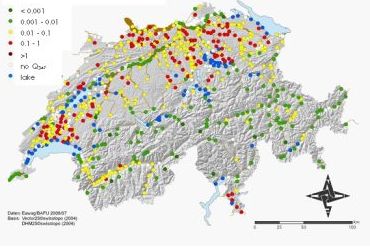Department Process Engineering
Model study Switzerland
Exposure assessment
Little is known about the current status of Swiss surface waters with respect to the micropollutants. Measurements conducted by cantonal authorities or within research projects show broad differences. For example, the measured concentrations of the anti-epileptic drug carbamazepine varies between <10 and >400 ng/L (see Figure 1).
It would be very time- and money consuming to conduct a measurement campaign that covers a large part of Swiss surface waters. Furthermore, the results of such a measurement campaign would be difficult to interpret as various factors may influence the result (e.g. season, selection of watercourses, measured substances).

Measured concentrations of the anti-epileptic drug carbamazepine in Swiss rivers. The large variation mainly refers to the fraction of treated wastewater in the river.
Mass-flux study
In order to get a balanced overview on the current situation, a GIS-based substance-flow model was developed at Eawag’s Environmental engineering department. Based on sales- or consumption data, substance characteristics, data from wastewater treatment plants and surface waters, the load of a substance downstream of every WWTP can be calculated. When combining these results with the river flow data, the concentration of the substance can be estimated. The calculated concentrations were compared to the measured concentrations and showed a good correlation. It was shown that elevated concentrations of problematic substances are expected in small rivers with a high fraction of treated wastewater, mainly in the Swiss plateau. In some rivers the PNEC-values (predicted no effect concentration) for several substances (e.g. hormones, diclofenac; see Figure 2) were exceeded, which means, that effects on aquatic organisms may be expected.

Calculated diclofenac concentrations in Swiss surface waters downstream of wastewater treatment plants at minimal river flow (Q347). There is an ecotoxicologically based threshold value for diclofenac of 100 ng/L. This value is exceeded downstream of the red wastewater treatment plants (every dot in the figure represents a WWTP, the color indicates the calculated concentration in the receiving water).
Scenario analysis
Considering the results of the mass-flux study, scenarios for the reduction of the micropollutants input from wastewater could be defined, e.g. by taking measures on selected WWTP. Possible scenarios are:
- Upgrade all WWTP larger than 50'000 PE
- Upgrade all WWTP where the threshold value for diclofenac is exceeded
- Upgrade all WWTP discharging into lakes
The impact of these scenarios was calculated by the model. By combining the scenarios with a cost-study for advanced technologies (ozonation, PAC-adsorption), which also was conducted within the project „Strategy Micropoll“, the costs for these scenarios were estimated.
